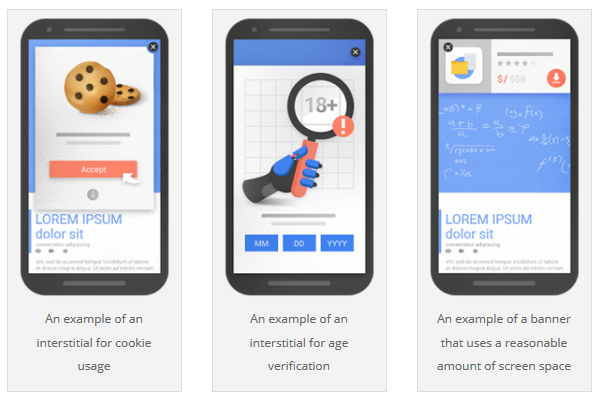Google goes after “Intrusive” Interstitials on Mobile
Google recently announced an upcoming algorithmic “penalty” which once rolls out will demote mobile pages that have “intrusive” interstitials.
Pages with “intrusive” interstitials can create frustration to the users as they are unable to easily find or access the content that they were expected to find when they clicked on the organic search result
How do I know if my interstititals are going to affect my mobile rankings?
According to Google:
Pages where content is not easily accessible to a user on the transition from the mobile search results may not rank as highly.
Examples of bad interstititals on mobile that make content less accessible
Google gave the following 3 examples of techniques that make content less accessible to a user:
- Showing a popup that covers the main content, either immediately after the user navigates to a page from the search results, or while they are looking through the page.
- Displaying a standalone interstitial that the user has to dismiss before accessing the main content.
- Using a layout where the above-the-fold portion of the page appears similar to a standalone interstitial, but the original content has been inlined underneath the fold.

Examples of interstitials that won’t be affected by the update, if used responsibly
There are though cases where an interstitial might be required, for example the cookies notification in European union countries. Google gave the following 3 examples of techniques that, if are used responsibly, won’t be affected by the update:
- Interstitials that appear to be in response to a legal obligation, such as for cookie usage or for age verification.
- Login dialogs on sites where content is not publicly indexable. For example, this would include private content such as email or unindexable content that is behind a paywall.
- Banners that use a reasonable amount of screen space and are easily dismissible. For example, the app install banners provided by Safari and Chrome are examples of banners that use a reasonable amount of screen space.

Google drops the app-install interstitials from their signals
Back in November 2015 Google announced an update on mobile-friendly algorithm saying:
Pages with an app install interstitial that hide a significant amount of content on the transition from the search result page won’t be considered mobile-friendly.
In order to avoid duplication in their ranking signals, Google said that:
We previously explored a signal that checked for interstitials that ask a user to install a mobile app. As we continued our development efforts, we saw the need to broaden our focus to interstitials more generally. Accordingly, to avoid duplication in our signals, we’ve removed the check for app-install interstitials from the mobile-friendly test and have incorporated it into this new signal in Search.
Google has also updated the Search Console mobile usability report adjusting it accordingly based on the change to the app interstitial ad penalty.
App install interstitials will no longer trigger an error in the Mobile Usability report; therefore, you may see a drop in errors in this report. However, although no longer reported as an error, the presence of all types of intrusive interstitials are used as a ranking factor for pages in mobile search results.
Will the upcoming penalty be applied on site or page level?
According to Gary Illyes the algorithm will affect individual pages and not the whole site.
@digitalwhat the algorithm affects individual pages, not whole sites @googlewmc
— Gary Illyes (@methode) August 27, 2016
When is the Google Interstitials Mobile Penalty going to roll out?
January 10, 2017. That gives plenty of time to webmasters and businesses to readjust their mobile interstitials and make sure their web pages will continue to rank as they used after the update.
